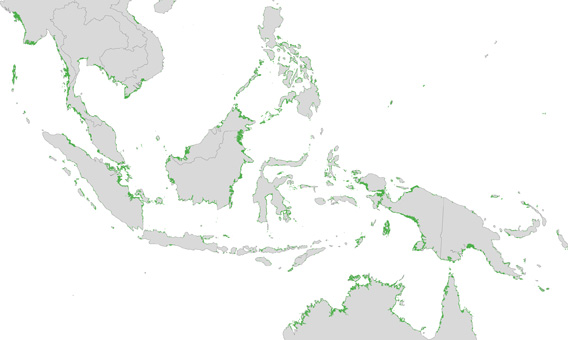
Extent of mangroves in Southeast Asia. Image courtesy of NASA and the US Geological Society. Click to enlarge.
Mangroves reduce wave height by as much as 66 percent over 100 meters of forest providing a vital buffer against the impacts of storms, tsunamis, and hurricanes, according to a new report published by The Nature Conservancy and Wetlands International.
“Waves are most rapidly reduced when they pass through a greater density of obstacles. This means that mangroves with aerial roots attenuate waves in shallow water more rapidly than those without,” said lead author Anna McIvor of TNC. “When the water gets deeper, waves may pass above aerial roots, but then the lower branches can perform a similar function.”
The findings, which are consistent with other research, add urgency to the effort to protect mangrove forests, which worldwide are disappearing faster than rainforests. Since 1980 more than a fifth of global mangrove forests have been cleared for coastal construction, agriculture, industrial shrimp farms, and fuelwood.
Loss of mangroves jeopardizes more than coastal human settlements however. Mangroves serve as nurseries for fish, store massive amounts of carbon, buffer against erosion, and act as a sort of filter along waterways. Other studies suggest that mangroves are worth upwards of $35,000 per year for fisheries and carbon sequestration alone.
Yet despite their importance, less than 10 percent of mangrove forests are protected worldwide. The new report argues that governments should invest more in these ecosystems to protect infrastructure and coastal communities.
“Mangroves are the best and cheapest way to protect coastal areas from waves,” said Wetlands International Indonesia’s director Nyoman Suryadiputra.
CITATION: McIvor, A.L., Möller, I., Spencer, T. and Spalding. M. (2012) Reduction of wind and swell waves by mangroves. Natural Coastal Protection Series: Report 1. Cambridge Coastal Research Unit Working Paper 40. Published by The Nature Conservancy and Wetlands International. 27 pages. ISSN 2050-7941.
Related articles